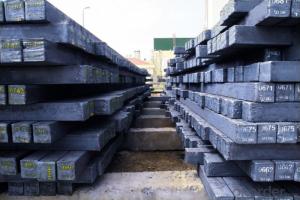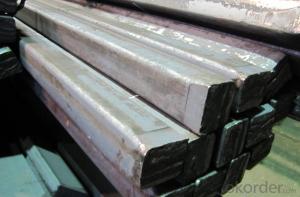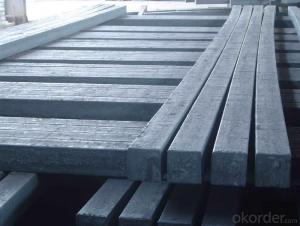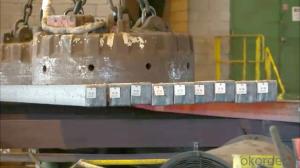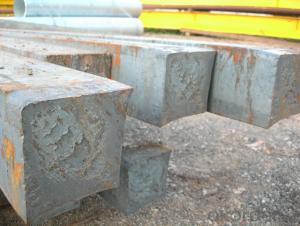Hot Rolled Steel Billet 3SP Standard 170mm
- Loading Port:
- Shanghai
- Payment Terms:
- TT OR LC
- Min Order Qty:
- 100 m.t.
- Supply Capability:
- 10000 m.t./month
OKorder Service Pledge
OKorder Financial Service
You Might Also Like
Structure of Hot Rolled Steel Billet 3SP Standard 170mm

Description of Hot Rolled Steel Billet 3SP Standard 170mm
Prepainted Rolled steel Coil is a kind of coated steel coil/sheet. With the cold rolled steel of different strength and thickness as substrate, it is produced through applying Al-Zn coat on both faces by hot dip process. In its coating, Al accounts for about 55%, Si 1.6%, while the remaining is Zn. Aluminum zinc coils enjoys both the physical protective feature and durability of Al and the electrochemical protective property of Zn. And its surface has bright silver color and regular embossed-like figure, which are highly decorative. RAL Scale Z35 Prepainted Rolled Steel Coil for Construction Roofing

Main Feature of Hot Rolled Steel Billet 3SP Standard 170mm
1.Corrosion resistance: It mainly depends on the zinc protection. When the zinc being worn,
2. Heat resistance: steel sheet has excellent heat resistance, can withstand high temperatures over 300 centigrade, and is similar with aluminized steel high temperature oxidation resistance. It often used in chimney pipes, ovens, fluorescent lighting device and the device cover.
3. Heat reflective: Galvanized steel plate heat-reflective high rate is twice as galvanized steel, often used to make insulation materials. RAL Scale Z35 Prepainted Rolled Steel Coil for Construction Roofing
Applications of Hot Rolled Steel Billet 3SP Standard 170mm
1. Construction and building: roofing; ventilating duct; handrail; partition panel;etc.
2. Electric appliance: refrigerator; washing machine; refrigerator; DVD;etc.
3.Transportation: oil tank; gas tank;road sign; etc.
4.Agriculture constructions :barn; etc.RAL Scale Z35 Prepainted Rolled Steel Coil for Construction Roofing
5.Others:vending machine; game machine; auto parts spare parts etc.
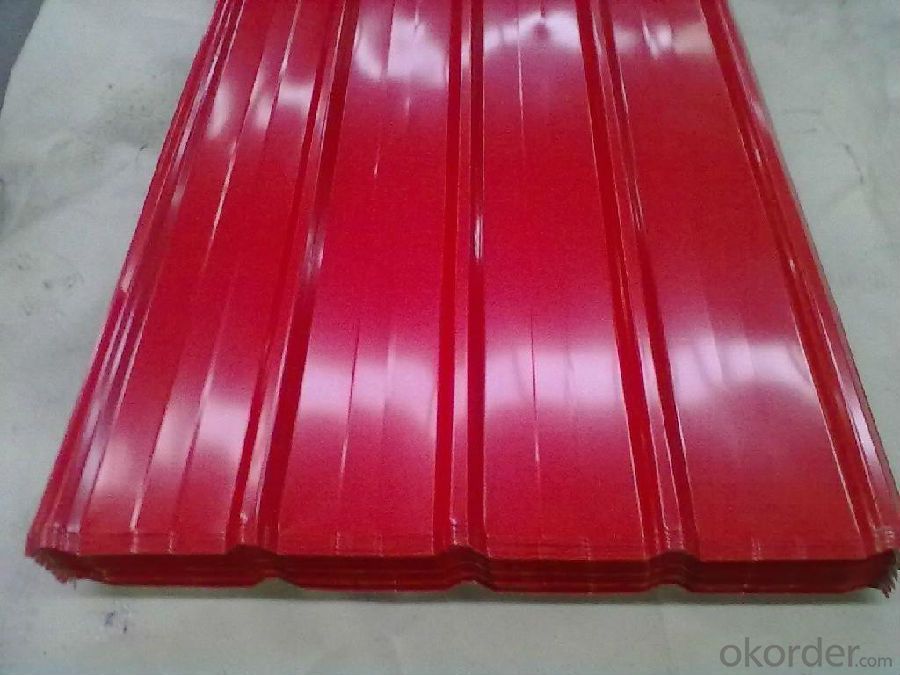
Specifications of Hot Rolled Steel Billet 3SP Standard 170mm
Product | Hot Rolled Steel Billet 3SP Standard 170mm |
Material Grade | SGCC / SGCH / DX51D+AZ, etc |
Thickness | 0.5-3.0mm |
Width | 700-1500mm |
Tolerance | Thickness: +/-0.02mm , Width:+/-2mm |
Zinc-coating | AZ30-150g/m2 |
Technique | Raw material: Hot rolled steel coil --> Cold rolled_>hot dipped galvalume |
Surface | Dried, Chromated, Unoiled,RAL Scale Z35 Prepainted Rolled Steel Coil for Construction Roofing |
Spangle | Regular spangle , small spangle, zero spangle |
ID | 508MM 610MM |
Coil weight | 25MT max |
Export package | Cardboard inner sleeves, Waterproof paper, galvanized steel covered and steel strip packed |
FAQ of Hot Rolled Steel Billet 3SP Standard 170mm
We have organized several common questions for our clients,may help you sincerely:
1. What is the minimum order quantity ?
Our MOQ is 100 mt for each size each specification. Usually we can offer discount if can buy large QTY once. RAL Scale Z35 Prepainted Rolled Steel Coil for Construction Roofing
2. How long can we receive the product after ordering?
Our general delivery time is 30 days after confirmation, but so some special orders, we have offer special delivery time
3. How to guarantee the quality of the products?
We have established the international advanced quality management system ,every link from raw material to final product we have strict quality test;We resolutely put an end to unqualified products flowing into the market. At the same time, we will provide necessary follow-up service assurance.
4. What is the payment?
We accept T/T, L/C
- Q:What are the common heat treatment processes for steel billets?
- Steel billets can undergo several heat treatment processes to modify their mechanical properties, including hardness, strength, and toughness, to meet specific requirements for different applications. One prevalent heat treatment process for steel billets is annealing. This involves heating the steel to a specific temperature and maintaining it at that temperature for a set duration, followed by gradual cooling. Annealing helps alleviate internal stresses in the steel, improve its machinability, and enhance its ductility. Another widely used heat treatment process for steel billets is quenching and tempering. Quenching involves rapidly cooling the steel from a high temperature to room temperature using a liquid or gas medium, like water or oil. This process results in hardened steel with increased strength and hardness. However, the steel becomes brittle after quenching, so it is then tempered by reheating it to a lower temperature and holding it at that temperature for a specific time period. Tempering reduces brittleness and improves the toughness and ductility of the steel. Normalizing is another heat treatment process employed for steel billets. It entails heating the steel to a temperature above its critical transformation temperature and then cooling it in still air. Normalizing helps refine the grain structure of the steel, improve its mechanical properties, and enhance its machinability. Lastly, stress relieving is a process used to reduce internal stresses in steel billets that may have been generated during manufacturing processes such as casting or forging. Stress relieving involves heating the steel to a specific temperature and maintaining it at that temperature for a certain duration, followed by gradual cooling. This process aids in improving dimensional stability and reducing the risk of distortion or cracking in the steel. Overall, these common heat treatment processes for steel billets play a vital role in optimizing the properties and performance of steel for various industrial applications, including automotive, construction, aerospace, and energy sectors.
- Q:How are steel billets heat-treated?
- Steel billets are typically heat-treated through a process called annealing, which involves heating the billets to a specific temperature and then slowly cooling them. This helps to relieve any internal stresses and improve the overall strength and ductility of the steel.
- Q:How are steel billets used in the manufacturing of construction machinery?
- Steel billets are used in the manufacturing of construction machinery as raw material for forging, casting, and machining processes. They are formed into various components such as gears, shafts, frames, and structural parts, providing the required strength and durability for heavy-duty applications in the construction industry.
- Q:How do steel billets contribute to the overall vibration resistance of a product?
- Steel billets contribute to the overall vibration resistance of a product by providing a strong and rigid foundation. The high strength and stiffness of steel billets help to absorb and dissipate vibrations, preventing excessive movement and reducing the risk of structural damage. Moreover, their dense and homogeneous composition minimizes resonance effects, further enhancing the product's vibration resistance.
- Q:Billet prices skyrocketing weekend, Southern China steel prices rose?
- So, three month contract period, even transportation during two days, there will be a big money and lose big reversal.
- Q:What are the different shapes of steel billets?
- Steel billets can come in various shapes, including square, round, rectangular, and hexagonal.
- Q:Can steel billets be used in the production of energy infrastructure?
- Yes, steel billets can be used in the production of energy infrastructure. Steel is a widely used material in the construction of various energy infrastructure components such as power plants, transmission towers, pipelines, and wind turbine towers. Steel billets, which are semi-finished steel products, can be further processed and shaped into the required forms for these infrastructure projects. The strength, durability, and versatility of steel make it suitable for withstanding the harsh conditions and heavy loads associated with energy infrastructure. Additionally, steel offers excellent corrosion resistance, which is crucial for infrastructure exposed to the elements. Overall, steel billets play a vital role in the production of energy infrastructure, contributing to the reliable and efficient generation, transmission, and distribution of energy.
- Q:What is the role of steel billets in the automotive industry?
- In the automotive industry, steel billets play a crucial role in the production of various components and parts for vehicles. Steel billets are essentially semi-finished steel products that undergo further processing to be transformed into the desired shape and size required for automotive applications. One of the primary uses of steel billets in the automotive industry is for the production of engine and transmission components. These include crankshafts, connecting rods, camshafts, gears, and other parts that require high strength and durability. Steel billets are used as raw material for forging or casting these components, ensuring they can withstand the rigorous demands of engine operation. Another significant application of steel billets in the automotive sector is for the production of structural components. These components, such as chassis frames, suspension parts, and body panels, require high strength and stiffness to provide safety and rigidity to the vehicle. Steel billets are processed through various techniques like hot rolling, cold rolling, or extrusion to produce the necessary forms and shapes needed for these structural components. Moreover, steel billets are also utilized in the manufacturing of fasteners like bolts, nuts, and screws, which are essential for assembling different parts of the vehicle. These fasteners need to possess excellent tensile strength and resistance to vibration and corrosion, making steel billets an ideal choice for their production. Additionally, steel billets find application in the production of various other automotive components, such as axles, wheel hubs, brake discs, and steering system parts. All these components require the superior mechanical properties offered by steel billets, including high strength, toughness, and resistance to wear and tear. In summary, steel billets play a vital role in the automotive industry by serving as the raw material for the production of engine and transmission components, structural components, fasteners, and other crucial parts. Their exceptional mechanical properties make them an ideal choice for applications that demand high strength, durability, and reliability, ensuring the safety and performance of vehicles on the road.
- Q:What are the main factors affecting the corrosion resistance of alloy steel billets?
- The corrosion resistance of alloy steel billets can be influenced by several key factors. Firstly, the resistance to corrosion is determined by the composition of the alloy steel. Steels with a higher percentage of elements like chromium, nickel, and molybdenum tend to have improved corrosion resistance compared to steels with lower alloy content. Secondly, the application of protective surface coatings or finishes can greatly enhance the corrosion resistance of alloy steel billets. Coatings such as zinc or epoxy act as a barrier between the metal surface and the corrosive environment, preventing direct contact with corrosive agents. Furthermore, the corrosion resistance of alloy steel billets can be affected by the manufacturing process. Proper heat treatment and quenching processes can improve the microstructure of the alloy, resulting in a more corrosion-resistant material. The environment in which the alloy steel billets are exposed is also a crucial factor. Elements like temperature, humidity, pH levels, and the presence of corrosive substances can all impact corrosion resistance. For instance, high temperatures or acidic environments can accelerate corrosion, while dry or neutral conditions may have minimal impact. Lastly, the design and maintenance of structures or equipment made from alloy steel billets can influence their corrosion resistance. Considerations like avoiding moisture accumulation in sharp corners or crevices can help minimize the risk of corrosion. Regular inspection, cleaning, and maintenance can also prevent corrosion by promptly addressing any issues. To summarize, the key factors affecting the corrosion resistance of alloy steel billets include the steel's composition, the presence of protective coatings, the manufacturing process, the environmental conditions, and the design and maintenance practices. By considering these factors, manufacturers and users can ensure optimal corrosion resistance in various applications of alloy steel billets.
- Q:For example, screw plate (PU plate and manganese plate), carbon steel Primeton is what person rolling out?.
- Primeton Pu board generally refers to A3; carbon steel refers to the high quality carbon steel, such as No. 45 steel, 35 steel and so on;
1. Manufacturer Overview |
|
|---|---|
| Location | |
| Year Established | |
| Annual Output Value | |
| Main Markets | |
| Company Certifications | |
2. Manufacturer Certificates |
|
|---|---|
| a) Certification Name | |
| Range | |
| Reference | |
| Validity Period | |
3. Manufacturer Capability |
|
|---|---|
| a)Trade Capacity | |
| Nearest Port | |
| Export Percentage | |
| No.of Employees in Trade Department | |
| Language Spoken: | |
| b)Factory Information | |
| Factory Size: | |
| No. of Production Lines | |
| Contract Manufacturing | |
| Product Price Range | |
Send your message to us
Hot Rolled Steel Billet 3SP Standard 170mm
- Loading Port:
- Shanghai
- Payment Terms:
- TT OR LC
- Min Order Qty:
- 100 m.t.
- Supply Capability:
- 10000 m.t./month
OKorder Service Pledge
OKorder Financial Service
Similar products
New products
Hot products
Related keywords

